Archives
April, 2013
Select a different month in the archive
Differences in Identical Twins Reveal Autism Risk Factor
By Chelsea E. Toledo, M.A. on April 30, 2013
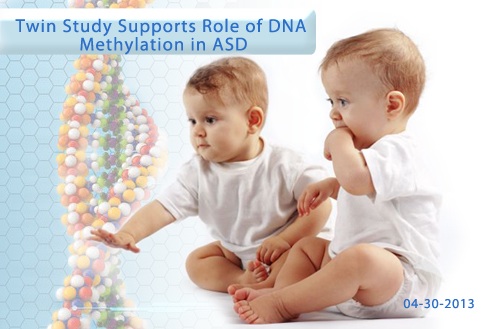
Background: Research has demonstrated that autism spectrum disorder (ASD) is highly heritable, suggesting a genetic basis. However, within pairs of identical twins—who have the same DNA—one sibling can have ASD, while the other doesn’t. That discordance points to the possibility of epigenetic factors, or those related to the variable expression of DNA, linked to the disorder.
What’s New: On April 23, 2013, the journal Molecular Psychiatry published a study analyzing epigenetic differences in identical twins, as related to ASD. The researchers took blood samples from 50 pairs of identical twins—with matching ASD diagnoses, mismatched ASD diagnoses, or matching typical development. They found variations in DNA methylation patterns—a form of epigenetic modification—at certain regions in the genomes between identical twins with different severities of autism. DNA methylation can be viewed as a mechanism to fine-tune gene expression. While identical twins have the same DNA sequence, their methylation patterns can fluctuate, potentially resulting in different diagnostic outcomes.
Why it’s important: This is the first large-scale study to examine the relationship between ASD and epigenetic differences in twins. The findings could point the way to treatment and prevention strategies based on patterns of DNA methylation.
Help me understand :
| Source(s) : |
| Tweet |
Antidepressant Use In Pregnancy Linked to Autism Risk
By Chelsea E. Toledo, M.A. on April 25, 2013
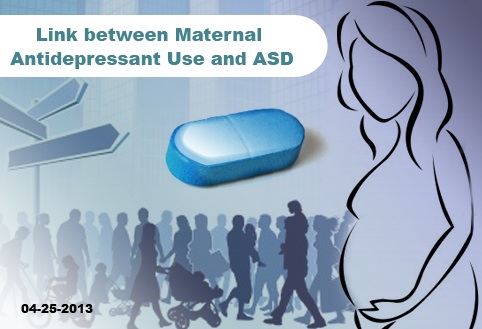
Background: In the past three decades, the rate of diagnosis for autism spectrum disorder (ASD) has increased dramatically—from one in 2,000 children to one in 88. While that uptick could be attributed to changes in diagnostic criteria, researchers are interested in identifying causal factors for ASD. Recent studies have suggested that depression or antidepressant use in parents could be associated with the development of ASD in resulting offspring.
What’s New: On April 19, 2013, British Medical Journal featured a study on parental depression and antidepressant use during pregnancy, with relation to ASD in children. Using publically available health records of 4,429 autistic individuals in Sweden, the researchers calculated the likelihood of an autism diagnosis as related to a family history of depression and maternal antidepressant use. Comparing the results to those of 43,277 controls, they determined that use of SSRIs and other antidepressants during pregnancy could account for about 1 percent of ASD cases.
Why it’s important: This is the second paper in two years to suggest a link between antidepressant use and ASD. However, because only a small fraction of ASD cases in the study appeared to be caused by maternal antidepressant intake, the increase in diagnoses is unlikely to be attributed to the drugs.
Help me understand :
| Source(s) : |
| Tweet |
Autism Linked to Atypical Visual Attention in Infancy
By Chelsea E. Toledo, M.A. on April 18, 2013
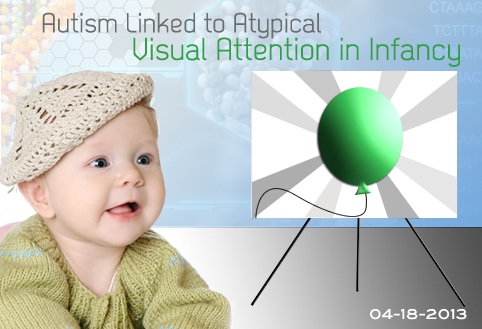
Background: Along with its hallmark social and communicative impairments, autism spectrum disorder (ASD) is commonly associated with a narrow focus of attention and interest. Studies of autistic adults have demonstrated that they experience increased activation in brain areas known for processing local versus global information—a pattern linked to superior performance on detail-oriented tasks.
What’s New: On January 29, 2013, the journal Biological Psychology featured a study of visual attention in infants, and its relation to ASD diagnoses later in life. The researchers videotaped 104 infants between six and 15 months of age as they watched animations either in the center of a screen or in its periphery. They found that the infants who were later diagnosed with ASD were more likely than their typically developing peers to continue focusing on the center of the screen after an animation moved to the periphery, and that they displayed inconsistent speed and flexibility in visual orientation.
Why it’s important: This study suggests that infants who develop autism have atypical development of visual attention beginning in the first year of life. However, infants who were later diagnosed with other developmental syndromes showed similar patterns in visual attention, underscoring possible overlaps in childhood disorders.
Help me understand :
| Source(s) : |
| Tweet |
Animals Postively Influence Children With Autism
By Stacy W. Kish on April 16, 2013
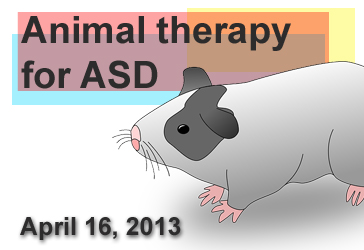
Background: Previous studies report that an animal can moderate stress in people. Children diagnosed with Autism Spectrum Disorder (ASD) often experience problems socializing with their peers and adults, leading to stressful interactions like bullying. A new study examines how animal interaction in the classroom environment benefits ASD children.
What’s new: Researchers at the University of Queensland, Brisbane, Australia evaluated the effect of guinea pigs or motivating toys in socialization of ASD children with their typically developing peers. The researchers found the ASD children spoke to their peers, looked at faces, smiled, and laughed more in the presence of animals compared to toys.
Why it’s important: Future therapies might engage animals to improve interaction between ASD children and their typically developing peers, as well as therapists and teachers.
Help me understand :
| Source(s) : |
| Tweet |
Oxytocin Alters Amygdala Activity to Social Stimuli
By Shana R. Spindler, PhD on April 11, 2013
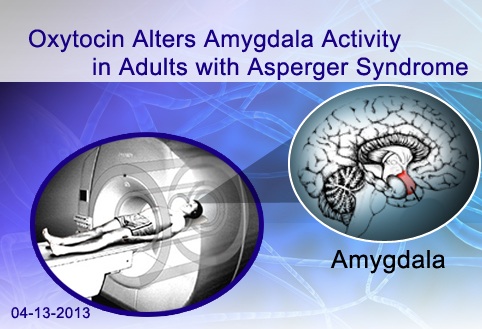
Background: Oxytocin is a hormone that is produced in the brain and released into the bloodstream and central nervous system, where it binds to oxytocin receptors on cells. Its role in helping labor contractions was discovered in the early 1900s, but more recently scientists have examined oxytocin’s ability to mediate social behaviors, presumably by modulating activity in the amygdala—a brain area known to be involved in social and emotional information processing.
What’s New: In a study published online March 6, 2013, in the journal Biological Psychiatry, researchers tested the effect of intranasal oxytocin supplementation on brain activity in response to social stimuli. The researchers administered either oxytocin or placebo, in a double-blinded manner, to 14 adult male volunteers with Asperger syndrome (AS) and 14 neurotypical control participants. They then measured amygdala activity using functional magnetic resonance imaging (fMRI) while the participants viewed images of houses and faces. Oxytocin supplementation significantly increased amygdala activity in response to faces, as compared to houses, in AS participants but not in controls. The placebo did not cause the same effect.
Why it’s Important: Ongoing clinical trials are testing if therapeutic oxytocin can alleviate social cognition difficulties in children and young adults with autism spectrum disorder (ASD). This is the first study to show an oxytocin-induced increase in amygdala activity during facial processing in individuals with Asperger syndrome.
Help me understand :
| Source(s) : |
| Tweet |
Genomic “Hot Spots” May Influence ASD Risk
By Eric Larsen, Ph.D. on April 9, 2013
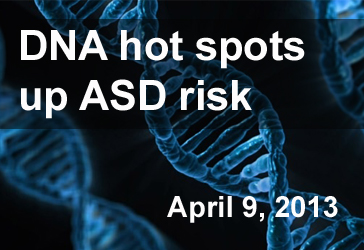
Background: De novo mutations that spontaneously arise in sperm or eggs and are subsequently transmitted from parents to children are thought to play a critical role in human disease, including autism spectrum disorder (ASD). In order to better assess the importance of de novo mutations in the genetics of ASD, it is necessary to understand what internal and external factors influence the onset of such variation.
What’s new: In a recent report in Cell, whole-genome sequencing was performed on ten pairs on monozygotic twins concordant with ASD and their parents. Whole-genome sequencing allows for the detection of genetic variation throughout the human genome, not only in genes. Sequencing of parental samples was performed to identify de novo mutations present in both monozygotic twins.
In agreement with recent ASD sequencing studies, paternal age was found to play a significant role in genome-wide variation, with the children of older fathers tending to have a greater number of de novo mutations. Rather than being randomly distributed throughout the genome, de novo mutations were more likely to be located in genomic “hot-spots” where the intrinsic properties of the DNA within these regions contributed to increased mutability. A number of genes and genomic regions that have been previously associated with ASD, such as the NRXN1 gene and the 15q11-q13 chromosomal region, were found to have elevated de novo mutation rates.
Why it’s important: These findings provide a better understanding of the factors that are responsible for ASD-associated de novo genetic variation. As DNA sequencing and analysis technology continues to progress, cataloguing ASD-linked “hot spots” in the human genome may aid in the development of screening and/or diagnostic genetic testing for autism.
Help me understand :
| Source(s) : |
| Tweet |
More Evidence Debunking Ties Between Vaccination & ASD
By Stacy W. Kish on April 4, 2013
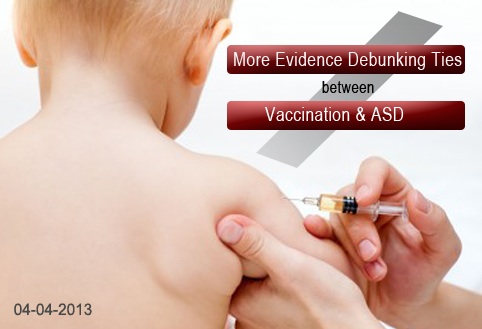
Background: After a rigorous review, the Institute of Medicine rejected the assertion that vaccinations cause autism spectrum disorder (ASD) in 2004. Despite this finding, many parents still express concern at the number and bundling of vaccinations administered to children in the first two years of life.
What’s new: Researchers at the Centers for Disease Control and Prevention conducted an intensive assessment of antibody-stimulating protein and polysaccharide content in vaccines administered to children between 1994 and 1999. These proteins and polysaccharides are molecules—known as antigens—that can stimulate an immune system response. The study, published in The Journal of Pediatrics, included 256 children with confirmed ASD and 752 control children. The researchers matched many variables between the two groups, including birth weight, maternal age, paternal age, education, and marital status.
Why it’s important: The researchers found that vaccinations are not a risk factor for developing ASD later in life, even when multiple vaccines are given at once. The results are relevant because the vaccinations children receive today contain a lower number of antigens than received by children before the year 2000, according to another study in the journal Pediatrics (Offit et al, 2002).
Help me understand :
| Source(s) : |
| Tweet |

